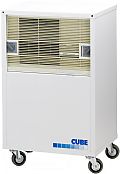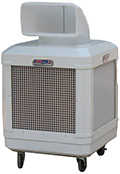
| ||||
| |
| |
| |
| |
| |
| |
| |
| |
| |
| |
W. Tombling Ltd.
Wembley House
Dozens Bank
West Pinchbeck
Spalding
Lincolnshire
PE11 3ND
U.K.


You are here:- home > cooling index > evaporative cooling homepage > portable evaporative air cooler index > evaporative air coolers and legionnaires disease
Industrial evaporative coolers and legionnaires disease
Portable industrial evaporative coolers operate in a very different way to cooling towers and evaporative condensers, as a result despite there being over 4 million portable evaporative coolers in use in the USA there is no evidence that one has caused an outbreak of legionnaires disease.
Portable industrial evaporative coolers such as the Waycool portable evaporative air cooler and Coolcube portable evaporative cooler are a completely safe way to cool industrial and commercial buildings.
However there is no room for complacency, employers using portable evaporative coolers must demonstrate to the Health and Safety Executive that they have:
- Identified and assessed the risks
- Prepared a scheme to control or eliminate the risk
- Nominated a ‘responsible person’ to manage the scheme
- Kept detailed and accurate records
Employers can demonstrate they are taking their responsibilities seriously by implementing a simple regular maintenance scheme for all portable evaporative coolers on their facility.
Regular water replacement - Monthly
Portable industrial evaporative coolers, even ones with a permanent mains water feed, should be completely drained and refilled with fresh water at least every 30 days.
Regular disinfection of evaporative coolers – 3 to 6 Months
Regular maintenance of industrial evaporative coolers extends their working life, improves efficiency and prevents odours. The precise maintenance period depends on water and air quality, but is normally in the range of 3 to 6 months.
• Completely drain the evaporative cooler and refill with a mixture of fresh water and household bleach (that has 4% available chlorine). Allow 5 millilitres of bleach for every 5 litres of water. This will give a concentration of approximately 20ppm of free chlorine. Do not exceed this concentration or the evaporative cooler could be damaged.
• Run the cooler without the fan (if your cooler allows) for 30 minutes.
• Empty the evaporative cooler and refill with fresh water. Operate for 5 minutes and drain the evaporative cooler to remove any chlorine residue.
• Repeat the above step.
• Refill with fresh water and check the evaporative cooler is running normally.
Servicing evaporative coolers before use
At the beginning of the summer of if the evaporative cooler hasn’t been used for more than 30 days, carry out the following steps:
• Disconnect power to the evaporative cooler
• Remove all covers and the cooling pads
• Wash the covers and pads using a hosepipe
• Clean all internal surfaces, using a stiff brush and water, to remove any scale and slime deposits.
• Refit the cooling pads and covers
• Disinfect the evaporative cooler, see regular maintenance above.
• Wash your hands
Storing evaporative coolers after use
At the end of the summer, or if the evaporative cooler is not going to be used for more than 30 days, carry out the following:
• Disconnect the power to the portable evaporative cooler
• Remove the covers and filters
• Use a stiff brush to loosen scale and slime
• Completely drain the cooler
• Clean the sump and all surfaces with a cloth soaked in diluted household disinfectant
• Wash the cooling pads with a hosepipe
• ONCE ALL THE COMPONENTS ARE DRY, reassemble the evaporative cooler. If the cooler has a drain valve, leave it open
• Store the portable evaporative cooler in a warm dry place. Do not cover the cooler
• Wash your hands
Conclusion
Correctly maintained and serviced, industrial portable evaporative coolers are completely safe. They present no risk of legionnaires disease, and are economic to run and maintain.
Industrial evaporative coolers use less energy than conventional air conditioning systems and enable doors and windows to be left open. Because there is a constant flow of fresh air into the building, which is filtered by the coolers, odours, germs and dust particles are removed and not recirculated around the building.
Further information
Visit the Health and Safety Executive website for more information on legionnaires disease in the workplace.
You are here:- home > cooling index > evaporative cooling homepage > portable evaporative air cooler index > evaporative air coolers and legionnaires disease
If you found this page useful, please take a moment
to tell a friend or colleague about it.
Copyright © 2004/6, W. Tombling Ltd.